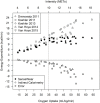Monitoring Energy Expenditure Using a Multi-Sensor Device-Applications and Limitations of the SenseWear Armband in Athletic Populations
- PMID: 29249986
- PMCID: PMC5714893
- DOI: 10.3389/fphys.2017.00983
Monitoring Energy Expenditure Using a Multi-Sensor Device-Applications and Limitations of the SenseWear Armband in Athletic Populations
Abstract
In order to monitor their energy requirements, athletes may desire to assess energy expenditure (EE) during training and competition. Recent technological advances and increased customer interest have created a market for wearable devices that measure physiological variables and bodily movement over prolonged time periods and convert this information into EE data. This mini-review provides an overview of the applicability of the SenseWear armband (SWA), which combines accelerometry with measurements of heat production and skin conductivity, to measure total daily energy expenditure (TDEE) and its components such as exercise energy expenditure (ExEE) in athletic populations. While the SWA has been shown to provide valid estimates of EE in the general population, validation studies in athletic populations indicate a tendency toward underestimation of ExEE particularly during high-intensity exercise (>10 METs) with an increasing underestimation as exercise intensity increases. Although limited information is available on the accuracy of the SWA during resistance exercise, high-intensity interval exercise, or mixed exercise forms, there seems to be a similar trend of underestimating high levels of ExEE. The SWA, however, is capable of detecting movement patterns and metabolic measurements even at high exercise intensities, suggesting that underestimation may result from limitations in the proprietary algorithms. In addition, the SWA has been used in the assessment of sleep quantity and quality as well as non-exercise activity thermogenesis. Overall, the SWA provides viable information and remains to be used in various clinical and athletic settings, despite the termination of its commercial sale.
Keywords: accelerometry; energy balance; high-intensity exercise; measurement error; resistance exercise.
Figures


Similar articles
-
Assessing energy expenditure in male endurance athletes: validity of the SenseWear Armband.Med Sci Sports Exerc. 2011 Jul;43(7):1328-33. doi: 10.1249/MSS.0b013e31820750f5. Med Sci Sports Exerc. 2011. PMID: 21131865
-
Accuracy of the Polar S810i(TM) Heart Rate Monitor and the Sensewear Pro Armband(TM) to Estimate Energy Expenditure of Indoor Rowing Exercise in Overweight and Obese Individuals.J Sports Sci Med. 2010 Sep 1;9(3):508-16. eCollection 2010. J Sports Sci Med. 2010. PMID: 24149647 Free PMC article.
-
Validation of the SenseWear Pro3 Armband using an incremental exercise test.J Strength Cond Res. 2014 Oct;28(10):2806-14. doi: 10.1519/JSC.0b013e3182a1f836. J Strength Cond Res. 2014. PMID: 25250859
-
Physical activity assessment in the general population; instrumental methods and new technologies.Nutr Hosp. 2015 Feb 26;31 Suppl 3:219-26. doi: 10.3305/nh.2015.31.sup3.8769. Nutr Hosp. 2015. PMID: 25719789 Review.
-
Exercise, energy expenditure and energy balance, as measured with doubly labelled water.Proc Nutr Soc. 2018 Feb;77(1):4-10. doi: 10.1017/S0029665117001148. Epub 2017 Jul 20. Proc Nutr Soc. 2018. PMID: 28724452 Review.
Cited by
-
Exploring the Use of Mobile and Wearable Technology among University Student Athletes in Lebanon: A Cross-Sectional Study.Sensors (Basel). 2021 Jun 30;21(13):4472. doi: 10.3390/s21134472. Sensors (Basel). 2021. PMID: 34208798 Free PMC article.
-
Negative Energy Balance Does Not Alter Fat-Free Mass During the Yukon Arctic Ultra-The Longest and the Coldest Ultramarathon.Front Physiol. 2018 Dec 20;9:1761. doi: 10.3389/fphys.2018.01761. eCollection 2018. Front Physiol. 2018. PMID: 30662406 Free PMC article.
-
Associations between cardiorespiratory fitness, physical activity, intraindividual variability in behavior, and cingulate cortex in younger adults.J Sport Health Sci. 2019 Jul;8(4):315-324. doi: 10.1016/j.jshs.2019.03.004. Epub 2019 Mar 20. J Sport Health Sci. 2019. PMID: 31333884 Free PMC article.
-
Physical Activity Patterns in Frail and Nonfrail Patients With End-Stage Liver Disease.J Clin Exp Hepatol. 2022 May-Jun;12(3):887-892. doi: 10.1016/j.jceh.2021.10.013. Epub 2021 Oct 23. J Clin Exp Hepatol. 2022. PMID: 35677521 Free PMC article.
-
Efficacy of telemedicine intervention in the self-management of patients with type 2 diabetes: a systematic review and meta-analysis.Front Public Health. 2024 May 21;12:1405770. doi: 10.3389/fpubh.2024.1405770. eCollection 2024. Front Public Health. 2024. PMID: 38835608 Free PMC article.
References
Publication types
LinkOut - more resources
Full Text Sources
Other Literature Sources

